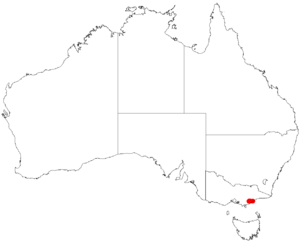Wellington mint-bush facts for kids
Quick facts for kids Wellington mint-bush |
|
|---|---|
 |
|
| In Royal Botanic Gardens Victoria | |
| Conservation status | |
| Scientific classification | |
| Genus: |
Prostanthera
|
| Species: |
galbraithiae
|
 |
|
| Occurrence data from AVH | |
The Prostanthera galbraithiae, often called the Wellington mint-bush, is a type of flowering plant. It is part of the mint family, known as Lamiaceae. This special shrub grows only in Victoria, Australia. It is an upright or spreading bush with fuzzy branches. Its leaves are narrow and egg-shaped. The plant produces beautiful deep mauve to purple flowers. These flowers have maroon dots inside their petal tube.
Contents
What Does the Wellington Mint-Bush Look Like?
The Wellington mint-bush is a shrub that can grow from 0.1 to 2 meters tall. Its branches are covered in dense hairs and are somewhat square. The leaves are a mid-green color. They are narrow and shaped like an egg or an oblong. When you crush the leaves, they smell like mint.
The leaves are 8 to 15 millimeters long and up to 2 millimeters wide. They are sessile, which means they attach directly to the stem without a stalk.
The flowers grow in groups of 8 to 24 near the ends of the branches. Each flower sits on a small stalk called a pedicel, which is 1.5 to 3 millimeters long. The sepals are green on top and maroon underneath. They form a tube about 2 to 2.5 millimeters long. This tube has two parts, each 2 to 3 millimeters long.
The petals are 7 to 10 millimeters long. They are deep mauve to purple with maroon spots in the center. The petals form a tube that is 3 to 3.5 millimeters long. This tube has two main parts, called lips. The lower lip has three smaller parts, or lobes. The middle lobe is 4 to 4.5 millimeters long and 3.5 to 5 millimeters wide. The side lobes are 3.5 to 4 millimeters long and 3 to 3.5 millimeters wide. The upper lobe is 3.5 to 5 millimeters long and 6.5 to 7 millimeters wide. This plant flowers from September to October.
How Did It Get Its Name?
The Wellington mint-bush was first officially described in 1998. A botanist named Barry Conn gave it its scientific name. This happened in a science journal called Telopea.
The second part of its scientific name, galbraithiae, honors Jean Galbraith. She was a member of the Latrobe Valley Field Naturalists. Jean helped discover this plant. She also worked hard to protect it. Giving plants scientific names helps scientists organize and study them. This system is called binomial nomenclature.
Where Does It Grow?
The Wellington mint-bush grows in sandy soil over clay. You can find it on the Gippsland plains in Holey Plains State Park in Victoria. It often grows in Eucalyptus obliqua woodlands. These woodlands have a healthy undergrowth of other plants.
Some plants that grow with it include Acacia oxycedrus and Epacris impressa. Other plants are Lepidosperma concavum, Leptospermum myrsinoides, and Platylobium obtusangulum. The Wellington mint-bush can become very common in an area after a bushfire. However, too many fires can be harmful. A group of these plants at Dutson Downs seems to have disappeared because of fires happening too often.
Protecting the Wellington Mint-Bush
This plant is considered "vulnerable" by the Australian Government. This means it is at risk of disappearing in the future. It is protected under the Environment Protection and Biodiversity Conservation Act 1999.
The main dangers to the Wellington mint-bush include:
- Fires that happen too often or at the wrong time.
- Maintenance of firebreaks, which are clear areas to stop fires.
- Using herbicides, which are chemicals that kill plants.
- Competition from other plants, like the bracken fern (Pteridium esculentum).


